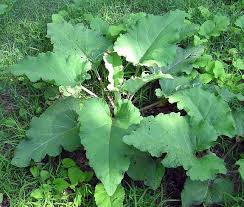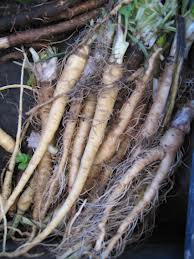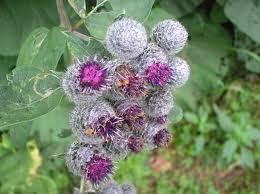Edible burdock is a biennial plant that can be found in many parts of the world as a source of food. Though the species is native to Europe and Asia, it can now be found in most regions worldwide.
Burdock plants have distinctive long, tapered seeds that are easy to identify. These burdock seeds stick to pantlegs and animal fur, aiding in seed dispersal. You may have found yourself slowly removing these seeds from your shoes or your dog.
The roots, flower stems, and leaves of burdock can all be eaten, and they have a variety of nutritional benefits. Once you learn how to identify and harvest burdock, you can safely eat and enjoy one of nature’s most bountiful wild plants. In this post, we will discuss where to find these edible plants, how to identify them, and what benefits they have for your health!
Burdock and Its Biennial Life Cycle
Burdock is a biennial plant, which means that it takes two years to complete its life cycle. In the first year of growth, the burdock plant produces large leaves and a long taproot. In the second year, the plant produces purple flowers and then seeds. After flowering and seed production, the plant dies.
When to Harvest
Burdock is often harvested at the end of its first fall or the beginning of its second spring, though you can harvest it as early as three months into its life cycle. At this point, the burdock will already have a notable taproot and small leaves that you can eat.
Because you can eat different portions of the burdock plant and because it has a two-year life cycle, the answer to the question “when can I harvest burdock?” is complicated. Different portions of the plant can be harvested at different times.
Where and How to Find Burdock
This wild food is found in many parts of the world. It grows best in moist areas with partial shade. You can find it growing along roadsides, in fields, and within forests.
Because burdock seeds stick to the clothes of people passing by, you can often find burdock along roads and walkways, where the seeds fell off and germinated.
Burdock Leaf ID
Burdock is easy to identify because of its large leaves and distinctive taproot. Its heart-shaped, dark, green leaves are broad and wavy, with a slightly hairy underside. The top of the edible leaves is often greener, while the underside is often whiter.

These leaves are arranged in a basal rosette shape. Burdock can grow up to six feet tall when it’s ready to flower, so look for plants with large leaves.
Burdock Flowers
Purple burdock flower heads can be easily identified by their long, colorful stamens that grow on top of what appears to be green, spiky balls. The purple flowers grow in clusters at the top of the plant and produce edible seeds. Seeds are brown with three black stripes running down the length of each seed.
How to Forage for and Prepare Burdock Roots
The roots of first-year burdock plants are considered to be ideal for foraging, but you can harvest the roots at any time. To harvest, use a shovel to dig a few feet deep around the plant until you expose the taproot. You can then pull up the entire plant or twist it to break off the root.
Sometimes it can be difficult to harvest burdock roots without snapping the edible parts, so move slowly and deliberately.
Once you’ve removed the burdock roots, cut off the top portion of the root, which will be visibly darker and tougher than the rest of the roots, as well as possibly unpleasant to eat.
How to Prepare and Eat Burdock Root
Burdock roots can be eaten raw, cooked, or pickled. Burdock root can also be cooked in a variety of ways, becomes soft, and has a slightly sweet and earthy flavor. It can be added to salads or used as a garnish on dishes. It can be boiled, steamed, or thrown in a stir fry with some olive oil. (Don’t forget to sprinkle some lemon juice on top!)
Preparing the root is similar to ginger in terms of texture and how it must be peeled. It can be stored similarly to ginger, too.
Burdock root is often sold commercially in Asian markets, and you can find many burdock recipes within Japanese cuisine. Roasted root, braised burdock root, and even burdock root fries are all ways that you can prepare the root of common burdock.
Pickled burdock is also popular in many countries. To make pickled burdock, soak the roots in vinegar for several days until they’re soft. Then add spices such as cinnamon, cloves, and ginger to give the pickles a flavorful kick.
Anti-Inflammatory Properties of Burdock Root
Burdock has also been shown to have anti-inflammatory properties. This means that burdock root may have medicinal purposes for people with conditions like arthritis or joint pain. A simple burdock recipe that takes advantage of these medicinal benefits is a basic tincture.

To make a burdock root tincture, soak the roots in vodka for several weeks. Then strain the liquid and store it in a dark glass bottle. To use, apply a few drops to the affected area.
How to Forage for Burdock Flower Stalks
Immature flower stalks from the burdock plant can be foraged and eaten. These stalks are edible raw or cooked. When raw, they have a slightly crunchy texture and a mild flavor. Flower stalks can also be boiled, steamed, or stir-fried.
To harvest, cut the flower stalk from the plant at the base. Then, peel the flower stalk twice, which leads to the best texture. Some suggest that cooking the stems at this stage results in a flavor similar to artichokes.

A good rule of thumb is to harvest the stalks when they are still solid throughout for the best texture and to leave them be once they have begun to hollow in the middle, likely before the burdock flowers are in full bloom.
How to Forage for Burdock Leaves
Burdock leaves are edible and can be eaten raw or cooked. When raw, the leaves have a slightly bitter flavor. The bitterness decreases when the leaves are cooked, and younger leaves are less bitter. The leaves can be boiled, steamed, or stir-fried.
To harvest the leaves, cut the young leaves from the plant at the base. The best way to prepare the leaves is to blanch them in boiling water for a minute or two, then shock them in cold water. This helps to remove some of the bitterness and make them more palatable.
If the leaves have already grown quite large, the leaf stems can be eaten as well. You can use burdock leaves to make a slaw, kraut, or any other dish you would create with leafy greens.
Nutritional Benefits of Burdock
Burdock is a good source of vitamins and minerals. It is especially high in vitamin C, which is an important nutrient for immunity. Burdock also contains other antioxidants that can help to protect the body from damage caused by free radicals.
The roots specifically have many health benefits and are often used to help with digestion, inflammation, and detoxification.
Fiber and Potassium
The burdock plant is also packed with prebiotic fiber, which is important for gut health. Prebiotic fiber helps to feed the good bacteria in the gut, and this can lead to a variety of health benefits.
Lastly, this low-calorie snack is also high in potassium, which can help to regulate blood pressure. Some studies have even shown that burdock can even help lower blood sugar.
Of course, always consult your doctor before turning to wild food for its health benefits.
FAQ About Burdock
Q: Is burdock safe for everyone to eat?
A: While burdock is generally safe for most people to eat, there are a few groups of people who should avoid it. Burdock may not be safe for pregnant or breastfeeding women because it contains compounds that can stimulate uterine contractions.
People with bleeding disorders or taking blood-thinning medication should also avoid burdock as it can increase the risk of bleeding.
Some people also experience contact dermatitis when handling burdock, so proceed carefully.
Q: Are there any dangerous burdock look-a-likes?
A: Sometimes burdock is mistaken with foxgloves, which is toxic. To tell the difference, look closely at the leaves. The veins of burdock leaves go to the edge of the leaf, while the veins of foxgloves leaves go upwards and tend to run almost parallel to the stem. Both foxgloves and burdock have a basal rosette leaf form.
Burdock is also sometimes mistaken for rhubarb, though rhubarb is edible as well. Though rhubarb also has a basal rosette leaf formation, you can tell the difference by looking at the stem, which is dark red in the case of rhubarb plants.
Always do your research before foraging for wild plants.
Q: How can I store burdock?
A: Burdock can be stored in the fridge for a few days or in the freezer for several months. To store, wrap burdock in a damp paper towel and place it in a plastic baggie. You can also blanch the leaves and stalks before freezing them.
Q: Can I grow burdock?
A: Yes, you can. But burdock is a biennial plant, so it will take two years to grow a full crop. Additionally, burdock grows so readily in the wild that you can probably find it growing nearby, instead.


